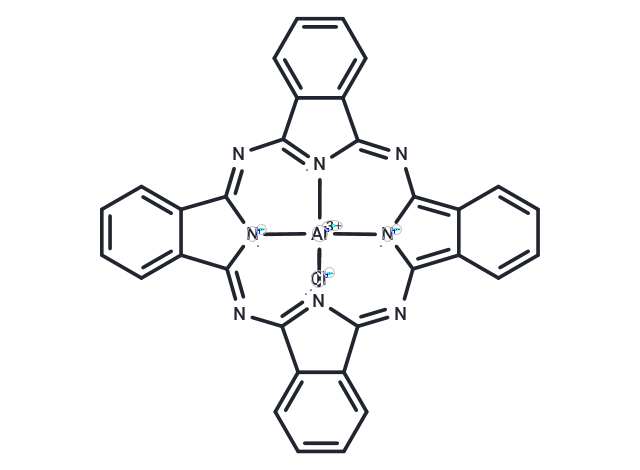Shopping Cart
Remove All Your shopping cart is currently empty
Your shopping cart is currently empty
Aluminum phthalocyanine chloride (Phthalocyanine Chloroaluminum) is an intensely blue-green-colored aromatic macrocyclic compound that is widely used in dyeing. Aluminum phthalocyanine chloride is a powerful photosensitizer and is useful in PDT.

| Pack Size | Price | USA Warehouse | Global Warehouse | Quantity |
|---|---|---|---|---|
| 25 mg | $40 | In Stock | In Stock | |
| 50 mg | $55 | In Stock | In Stock | |
| 100 mg | $76 | In Stock | In Stock | |
| 200 mg | $109 | - | In Stock | |
| 1 mL x 10 mM (in DMSO) | $39 | In Stock | In Stock |
| Description | Aluminum phthalocyanine chloride (Phthalocyanine Chloroaluminum) is an intensely blue-green-colored aromatic macrocyclic compound that is widely used in dyeing. Aluminum phthalocyanine chloride is a powerful photosensitizer and is useful in PDT. |
| Cell Research | Instructions 1. Solution preparation: Aluminum Phthalocyanine Chloride is dissolved in DMSO (anhydrous dimethylsulfonamide) or ethanol to prepare a solution of the required concentration. The recommended dissolution concentration is usually 1-10 mM, and the specific concentration can be adjusted according to the experimental requirements. 2. Cell treatment: 1) Infected cells: J774 macrophages (or other suitable cell lines) are co-cultured with Leishmania protozoa until the cells are infected. 2) Adding Aluminum Phthalocyanine Chloride: Add Aluminum Phthalocyanine Chloride solution to the infected cell culture medium. The common concentration range is 0.1-20 µM, and the specific concentration should be optimized according to the experimental requirements. 3) After addition, incubate the cells for usually 30 minutes to 1 hour so that the photosensitizer can be effectively taken up by the cells. 3. Light treatment: 1) Irradiate the cells with a light source of a specific wavelength (usually in the range of 660-680 nm). The choice of irradiation time and light intensity should be optimized according to the experiment, usually between 10-60 minutes. 2) Light can activate Aluminum Phthalocyanine Chloride and induce it to release reactive oxygen species (ROS), thereby killing parasites. 4. Evaluation of cell lysis and parasite clearance: 1) Parasite morphology observation: After light treatment, use a microscope to observe the morphological changes of parasites in cells. ROS caused by Aluminum Phthalocyanine Chloride can destroy the membrane structure of parasites, causing morphological changes or dissolution. 2) Cell lysis monitoring: 2) In order to monitor the efficacy of photodynamic therapy, cell survival and cell lysis can be evaluated by MTT assay, cell counting or fluorescent dyes (such as PI staining). Notes: 1. Aluminum Phthalocyanine Chloride solution should be stored in a cool and dry place and avoid long-term exposure to strong light to prevent photosensitizer degradation. 2. The solution should be stored at low temperature (such as 4°C) and avoid repeated freezing and thawing. |
| Synonyms | Phthalocyanine Chloroaluminum, Chloroaluminum Phthalocyanine |
| Molecular Weight | 574.96 |
| Formula | C32H16AlClN8 |
| Cas No. | 14154-42-8 |
| Smiles | [Cl-][Al+3]123[N-]4C=5C=6C(C4=NC7=[N]1C(=NC=8[N-]2C(=C9C8C=CC=C9)N=C%10[N]3=C(N5)C=%11C%10=CC=CC%11)C=%12C7=CC=CC%12)=CC=CC6 |
| Relative Density. | no data available |
| Storage | keep away from direct sunlight | Powder: -20°C for 3 years | In solvent: -80°C for 1 year | Shipping with blue ice/Shipping at ambient temperature. | ||||||||||||||||||||
| Solubility Information | DMSO: 5.79 mg/mL (10.07 mM), Sonication is recommended. | ||||||||||||||||||||
Solution Preparation Table | |||||||||||||||||||||
DMSO
| |||||||||||||||||||||
| Size | Quantity | Unit Price | Amount | Operation |
|---|

Copyright © 2015-2025 TargetMol Chemicals Inc. All Rights Reserved.